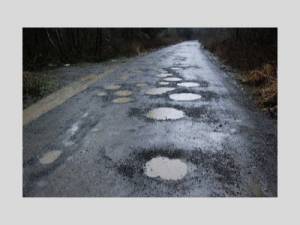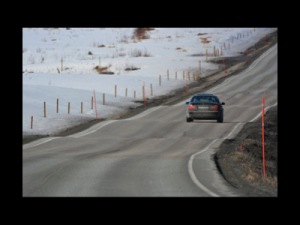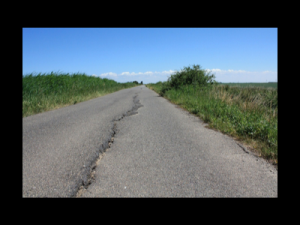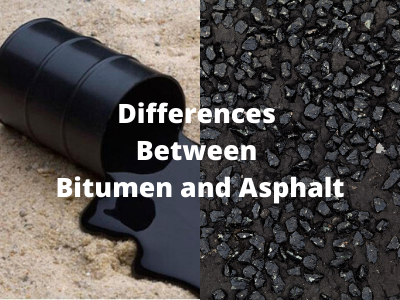Flexible pavement can be defined as one consisting of a mixture of asphaltic or bituminous material and aggregates deposited in layers above the subgrade on a bed of compacted granular material of suitable quality.
The various types of failures in flexible pavements are listed below:
- Subgrade failure.
- Base failure or base course failure.
- Surface failure or wearing course failure.
Table of Contents
Subgrade failure
Excessive deformation of an elastic failure in subgrade soil is referred to as subgrade failure in flexible pavement. This is one of the major causes of flexible pavements failure. This form of failure causes the asphalt surface to be undulated ups and downs and corrugated.
Causes of failure of subgrade:
- Inadequate stability.
- Inadequate road drainage.
- Excessive stress application
Base Course Failure
Excessive deformation in the base or baseline of a dynamic surface is known as baseline failure. This sort of failure causes potholes, waves, and corrugations on the surface of the flexible pavement.
Causes of failure of the base course:
- Insufficient strength.
- Loss of binding action.
- Crushing of base course material.
- Lack of lateral confinement of the granular base course.
- Insufficient wearing course.
- Inadequate quality control.
- Inadequate road drainage.
Surface Failure
Excessive deformation is called surface failure or wearing course failure in the wearing process of flexible pavement. This form of failure in the pavement system causes ruts, potholes, cracks, etc.
Causes of failure of the surface:
- lack of proper mix design
- Use of the inferior type of binder.
- Inadequate quality control.
- Volatilization and oxidation of binder.
Flexible Pavement Failure Forms due to Exposure
The exposure that affects the flexible pavements adversely are:
Weather conditions: Changing weather in dynamic pavements causes distress.
Chemical and salt use in colder climates: The frost heave and the stripping of asphalt due to snow and ice will result in potholes and other distress.
Ultraviolet rays: The ultraviolet rays make the asphalt oxidizing and take it to a fragile state. The surface temperature may be up to 140 degrees Celsius on a hot sunny day. This is the liquid asphalt softening point. This will stretch and push the flexible pavement. The temperature drop would cause the pavement to contract. The main reason for the initial cracking is this expansion and contraction.
Water (natural rain and irrigation): Water can penetrate the foundation and the subgrade through the cracks, resulting in structural damage.
Vehicle loads and petroleum: The car fuel spillage deteriorates the pavement’s quality. This will raise the binder’s softening rate. A parked vehicle has the possibility of leaking gasoline or brake fluid to liquefy asphalt. It makes the binder separate from the rock so that softer areas can be formed. Therefore, accidental treatment of oil spots should not be ignored in the parking area.
Aging of Flexible Pavements: Aging is a pavement’s life cycle degradation. It contributes to a rapidly accelerated development of corrosion and cracks. Small degradation at the initial stages can help to decrease the aging impact frequency. When the temperature and ultraviolet exposure increases the degradation rate.
Results of Flexible Pavement Failure
1. Ruts: Through elastic asphalt, longitudinal depressions or cuts are known as ruts.

Due to repeated traffic wheel loads at the same location, particularly under wheeled traffic, these are usually formed ion earth or W.B.M roads of one lane length.
2. Pot Holes: The isolated depressions are called potholes or gaps, more or less circular in shape formed in porous pavements.

Usually, these are produced in all types of elastic pavements due to the disintegration of road metal or the lack of binding surface track with the base.
3. Frost Heaving: A localized part of the surface heaving is referred to as frost heaving. Under cold climates, the rain that can gain entry to pavement structure freezes.

The contraction that follows this frost action creates disruption that can break the surface of the pavement.
4. Shear Failure Cracking: A fracturing or cracking forming due to pavement section upheaval followed by a depression called cracking shear failure. This form of failure occurs because of the pavement’s localized weakness.
5. Longitudinal Cracking: The development of cracks is called longitudinal cracking in the longitudinal direction of street pavement.

This loss is caused by frost effect, various subgrade volume shifts, filled material settling or side slopes sliding.
6. Map Cracking: Map cracking is called the creation of irregular cracks that are typically formed on the bituminous surface.
 This form of flexible road failure is due to excessive road surface wear or localized weakness in the base course underlying it.
This form of flexible road failure is due to excessive road surface wear or localized weakness in the base course underlying it.




